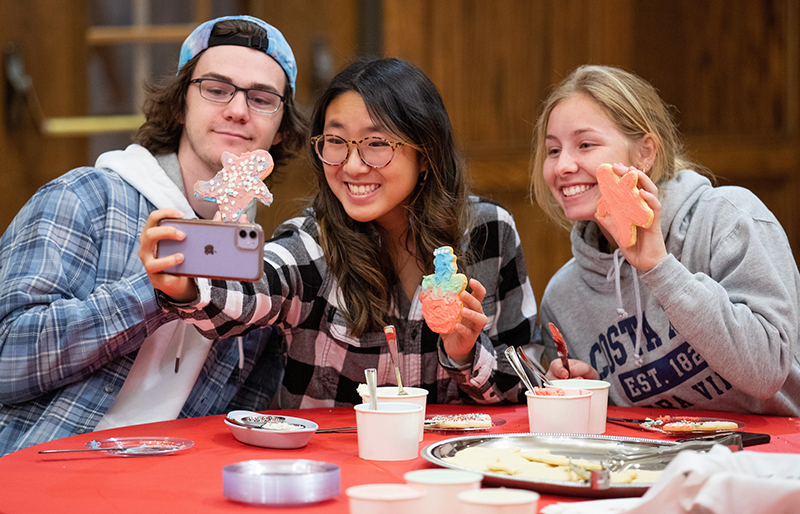Historic night in the stadium
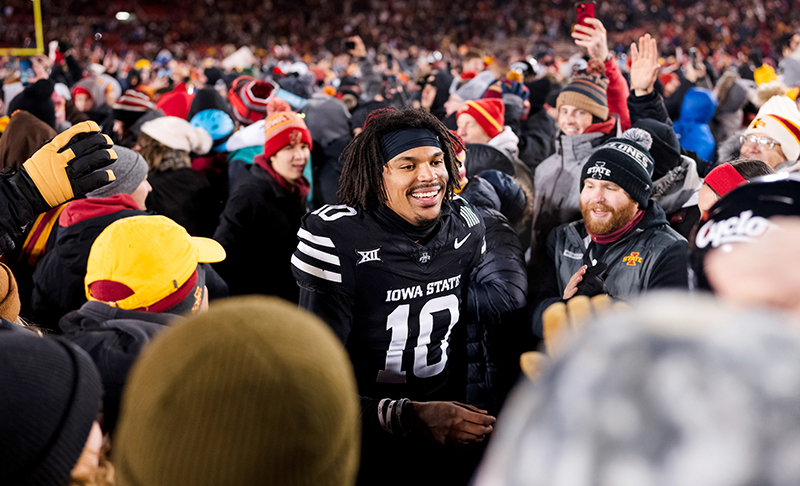
Photo by Jeff Spaur, ISU athletics communications.
Senior defensive back and special teams member Darien Porter (No. 10) celebrates the Nov. 30 Cyclone victory over Kansas State at midfield with thousands of fans. Porter blocked a Wildcat field goal attempt in the third quarter to preserve the Cyclones' lead. In addition to sending the team to the Big 12 Conference championship game this weekend, the win provided the football program its first 10-win regular season. (To clarify, the Cyclones' first 10-game regular season occurred in 1948, the year Colorado joined the former Big Six conference.)
The postseason title game in suburban Dallas begins at 11 a.m. Saturday, Dec. 7, against conference newcomer Arizona State Sun Devils. It's the first meeting ever for the two programs, who finished the regular season with identical records: 10-2 (7-2 in the conference). ABC TV will broadcast Saturday's game nationally.
Remembering Tahira Hira
Tahira Hira, emeritus professor of personal finance and consumer economics, died Dec. 4 after a long illness. Tahira served Iowa State University for more than 30 years as a faculty member and university administrator until her retirement in 2014.
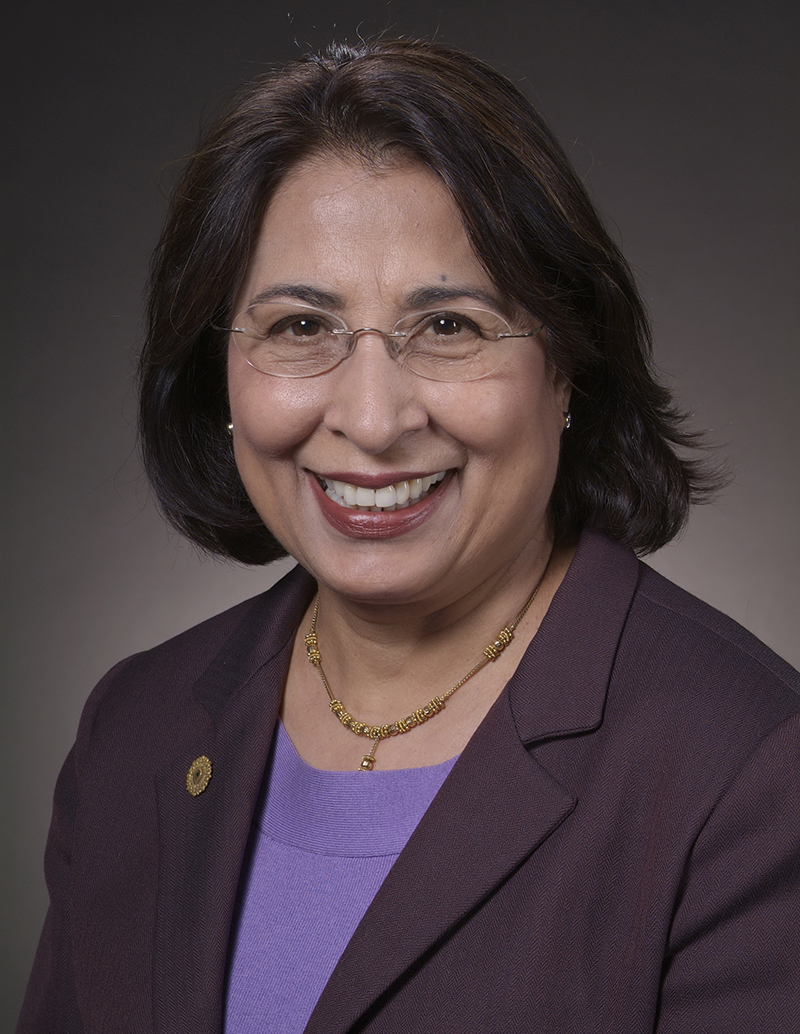
Tahira Hira
Recognized internationally for her research in family financial management, investing, consumer credit, bankruptcy, the borrowing behavior of college students and gambling, Tahira was a highly sought-after expert and consultant. She published more than 100 articles, made hundreds of presentations worldwide and served on numerous state and national committees and boards, including President George W. Bush's Advisory Council on Financial Literacy, the NYSE committee on financial literacy, and the Iowa Student Loan Board.
At Iowa State, Tahira was active in undergraduate and graduate teaching and research. She was the founder of Iowa State's Financial Counseling Clinic, the first-of-its-kind in the nation research and teaching laboratory. She developed a financial counseling option at the undergraduate level and taught several courses and programs in personal finance. She served as a major professor for 30 Ph.D. and M.S. candidates, supervised three postdoctoral fellows and sat as a member of 43 programs of study committees.
Tahira's administrative leadership positions included serving as associate vice provost for extension (1998-2002), executive assistant to President Gregory Geoffroy (2002-12) and senior policy advisor to President Steven Leath (2012-14).
Tahira and her husband, Labh, also have been philanthropic leaders at Iowa State. They generously supported projects and programs, including the Roger P. Murphy Professorship in Accounting, a named space in the Gerdin Business Building, women's athletics and numerous funds within the Ivy College of Business and the College of Health and Human Sciences.
In accordance with her wishes, no memorial service is planned. The Iowa State University community joins Labh in remembering his beloved wife, Tahira.
The human side of veterinary medicine
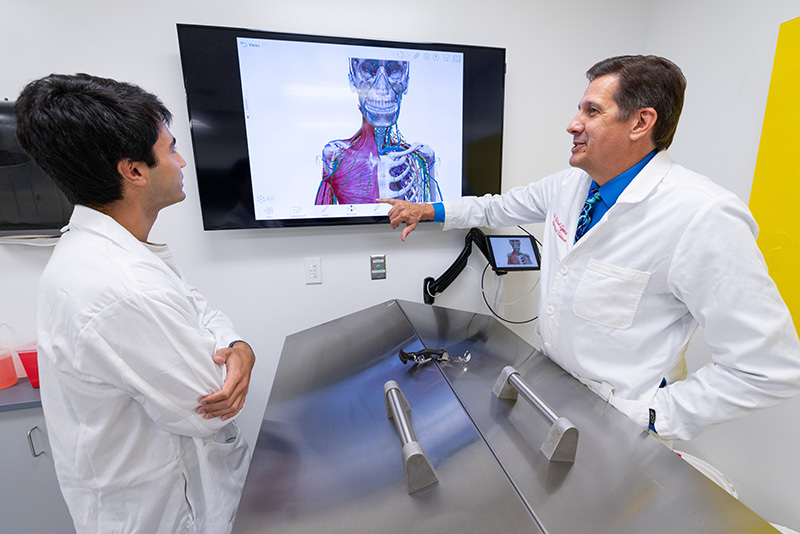
Biomedical sciences teaching professor Michael Lyons (right) uses a a flat-panel screen above a cadaver table during his discussion with a student in the human anatomy lab. Photos by Christopher Gannon.
Innovation can be found all over the College of Veterinary Medicine, even in storage rooms.
To aid students interested in human medicine, biomedical sciences teaching professor Michael Lyons and program specialist Bill Robertson converted a former storage room into a human anatomy lab to elevate the impact of the department's one-year master's degree. The intensive two-semester program, first offered in 2013, prepares students to work in industry, academia or continue their veterinary or human medical school education. Originally, students learned anatomy using dog cadavers, but with many students interested in medical school there was a need for a human anatomy lab.
"When Dr. Lyons was hired, he was adamant: If we're going to prepare students for professional health programs, we need human cadavers," Robertson said.
That became a reality in 2017.
Building the lab
Creating the human anatomy lab required overcoming two challenges: providing sufficient ventilation while maintaining a quiet environment for learning.
"Cadavers are embalmed with a solution that contains formaldehyde, so one of the things you must do is exhaust those fumes," Robertson said. "You could use a huge fan, but it would make so much noise students wouldn't be able to hear themselves think -- that doesn' make for a good learning environment."
To move enough air to eliminate the odor, Robertson and Lyons looked through the literature and found studies that used stainless steel dissection tables equipped with a downdraft exhaust feature. These tables draw fumes through perimeter ventilation slots, funneling them into a ductwork system connected to the building's exhaust.
"To accommodate the ventilation needs, we had walls constructed to provide space for new exhaust ductwork," Robertson said. "We used large ductwork and custom fittings to move a large volume of air at a low velocity while students are working.”
During labs, four students study a cadaver on one of six stainless steel tables. The tables have lids that open to expose the cadaver, and a button on the wall is depressed to increase airflow. Above each table is a wall-mounted flat-panel screen for viewing a dissection and an iPad loaded with a 3D anatomy program.
"When students are not in the lab, it's still necessary to ventilate the tables, but at a lower rate," said Lyons, who noted the delicate balance to avoid drying out the cadavers.
Environmental health and safety staff test the lab -- which remains at about 67 degrees -- twice a year to ensure the air quality meets safety standards. How successful is the design?
"When they measure the air quality in the human lab, formaldehyde fumes are below detection levels because the ventilation is so good," Robertson said. "We succeeded; there is no odor and the room is quiet."
Equally impressive is how fast the space was remodeled and readied for students. Construction began in May 2017 and was completed by fall semester.
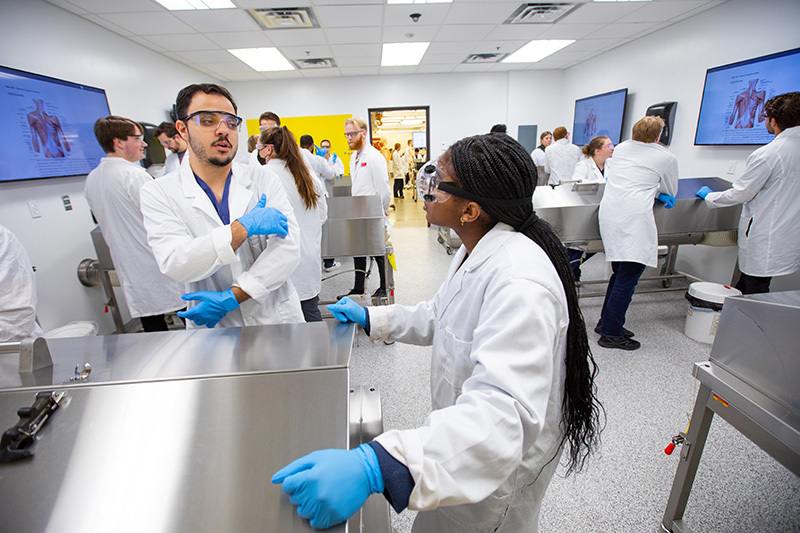
The human anatomy lab allows four students to study a cadaver on one of six stainless steel tables. A storage room was transformed into the lab in 2017.
Making the most of a gift
Lyons, who drew from his own experience during his Ph.D. years at the University of Iowa, teaches human anatomy to graduate students in the fall and undergraduates in the spring. Graduate students learn how to dissect during the fall semester, and undergraduates study those dissected donors in the spring.
"It really is about making the most out of the precious gift these donors provide," he said.
The University of Iowa Deeded Body Program provides embalmed human donors to Iowa State each August. At the end of the spring semester, the donors are returned to the University of Iowa, where they are cremated and a memorial service is held. The cremains are then returned to the donor's family. Lyons sets the tone in his class with one unbreakable rule.
"We tell our students these are human beings, and it doesn't matter that they are deceased," he said. "They are people, so treat them with respect. Any family member of someone who has been donated expects that, and we do, too."
In-demand seats
Human anatomy classes are in such demand the available spots fill up quickly each semester. The master's program in athletic training added the human anatomy class to its curriculum, so now the class is offered during the first half of summer and also is open to additional undergraduate and graduate students. The demand for health care professionals demonstrates the need for additional anatomy classes.
Because of space restrictions, during lab time, half of the students first work in the human lab and the other half in the gross anatomy room where veterinary students learn animal anatomy. Then the two groups switch.
Graduate students spend two hours in lecture and 7.5 hours in the lab weekly, while undergrads have two hours of lecture and four hours of lab work. Many students spend extra time in the lab but are required to work with a partner. A ceiling camera continuously monitors the lab, and only those with key cards have access. When they're done, students wipe down tables, mop floors and apply wetting solution to the bodies.
Student success
Lyons was honored with a university award for his teaching in 2024. In their nomination letters, students who went on to medical school praised Lyons' instruction for preparing them to excel.
"I focus on skills and how to think like an anatomist because that is where most students end up having the biggest issues, based on feedback from medical school anatomists," Lyons said. "The class is designed to help students deal with the amount of information they encounter, but at the same time, synthesize the material to make clinical applications."
He incorporates real-life examples so students must apply information they are learning and avoid relying on memorization. He also emphasizes learning how each organ, muscle or vein interacts with what's around it. Graduate students also get dissection experience, a skill not taught in a professional setting, Lyons said.
Lyons is the lone faculty instructor for the courses, but he uses recent graduates as lab instructors and grad students who excel during the fall work as teaching assistants in the spring.
"It allows them to keep working on the anatomy and get more experience," he said. "Many go on to be teaching assistants in their professional program."
One Health
The only restriction on growing the human anatomy program is space. Adjacent rooms aren't available for expansion, but that doesn't stop Lyons from imagining what a larger program could mean for students and the university.
"Not everyone understands the relationship between human and animal health," he said. "It's the concept of One Health, a more holistic look at health, which I think is a huge advantage to Iowa State."
Lyons thinks Colorado State University may be the only other veterinary medicine college with a human anatomy lab. He hopes to partner with veterinary faculty to create more opportunities for future veterinarians and doctors to interact and learn about the links between the two.
"Right now, we offer an optional experience at the end of first-year vet students' anatomy classes to observe the human donors," Lyons said. "It's neat for them to see something they haven't dissected as part of their training. My students benefit because they can talk to the DVM students about similarities and differences in human and animal anatomy. Since the human donors are older, vet students get to see more age-related pathologies than they can see during their first year of anatomy training."
How is a campus closure determined?
Michael Newton knows the decision never pleases everyone. Regardless, advising senior leaders on campus closures because of weather or another significant event always comes down to one thing -- safety.
"Not everyone likes it when you make the decision," said the chief of the Iowa State police department. "We tell everyone that if they don't feel comfortable coming to campus, they need to make that decision for themselves, whether we are open or not. It's always what is best for the individual."
Stay winter safe
A message from campus operations leaders about severe weather and emergency campus closings.
Newton's is one of many voices across campus and the state that weigh in to determine if campus will close. Closures are rare. One of the most recent occurred in 2019 when record-breaking wind chills compelled closure across parts of three days.
Virtual learning
The university community's forced pivot to virtual learning during the pandemic provides an alternative during severe weather for faculty, staff and students. Moving classes online keeps student learning in a safe environment and helps faculty stay on schedule with their syllabi. Policies provide guidance for faculty as they decide how to conduct courses, Newton said.
He noted that another option, a partial closure, typically involves moving classes online while critical campus services remain open.
The process
Newton said weather-related decisions often begin several days in advance with a review of extended forecasts as well as conversations with senior leaders and staff from:
- Public safety
- Environmental health and safety
- Facilities planning and management (FPM)
"We bring all these people together to monitor the weather, discuss campus preparedness and determine the ability of our faculty, staff and students to safely be on campus," he said.
Newton and the team also consults with National Weather Service (NWS) staff, who provide information and advice but are not involved in determining a closure. Newton said NWS staff conduct webinars in advance of significant weather events to provide current information and the potential impact.
Severe weather days begin at 4 a.m. or earlier for Newton, who checks in with the patrol supervisor to learn the current conditions across campus. Iowa State has 45 miles of paved roads and 52 miles of sidewalk maintained by FPM. Newton said in seven and a half years in his role, CyRide bus staff have never told him they could not operate, even if at a slower pace.
Ideally, a decision is made by 5 a.m. -- and may rely on information from the Iowa State Patrol about road conditions -- to keep early morning commuters off the roads if campus is closing.
Once Newton has gathered the information, he and general counsel Michael Norton decide on recommendations to give to President Wendy Wintersteen. Her senior leadership team makes the final decision.
In the event of a partial closure or move to virtual classes, information is shared through a campus message and posted on the ISU Alert page. University policy provides guidance and expectations for employees related to cancellations and closings.
Additional information for faculty and staff when campus operations are disrupted is available in an FAQ.
New Workday form will handle financial policy exception requests
The controller's office will launch a new policy and procedure exception form in Workday on Jan. 1, 2025, replacing email as the request tool. The intent is to improve the efficiency and transparency of financial and accounting compliance exception requests from faculty, staff and students.
The form will be found under the "create request" command in the "quick tasks" tile in Workday. Users will select the request type "policy and procedure exceptions."
This form is to be used for an exception to a financial and accounting compliance policy or procedure. Examples of these exceptions might include, but aren't limited to, hospitality expenses, lodging overage, meals (group, individual and per diem), combining personal and business travel or flying vs. driving travel expenses.
Requesting an exception will be the responsibility of the impacted employee. All requests will be directed through the system to the Financial and Accounting Compliance Team (FACT) for review. Submitting a request doesn't guarantee approval.
Starting Jan. 1, all exception requests must be submitted via this form; email requests no longer will be reviewed.
Key benefits of transitioning policy exception requests from email communication to the Workday platform are:
- Standardized communication: The new process enhances clarity and efficiency in submitting requests.
- Faster processing: The streamlined system will expedite review and approval, significantly reducing wait times for requestors.
- Documentation: All requests will be tracked and documented in Workday, providing visibility and accountability to the approval process. This record could help staff identify policies and procedures that may need more training and support.
Questions about accessing or completing the policy and procedure exception form in Workday may be sent to fact@iastate.edu.
Stay safe when winter weather moves in
This message was sent via email Dec. 1 to ISU faculty, staff and students:
Dear Iowa State Community,
Winter weather is here. We encourage you to be prepared for changing weather conditions and review the following information about campus closures and announcements.
Severe weather and emergency closings
There are occasions when the university may move to virtual classes or partially close campus due to weather conditions. University policy provides guidance and expectations for employees related to cancellations and closings. Additional information is available in this FAQ.
In the event of a partial closure, the university will maintain the following services: police/public safety, power plant, residence halls, food service, health care, animal care and critical maintenance, including ongoing research projects. Other campus offices have the flexibility to close or provide remote/virtual services.
University leaders encourage employees and students to put safety first when deciding to travel to campus. If you cannot make it to campus because of the weather, please coordinate with your supervisor or instructor to arrange to work remotely, take leave or make up class material.
Weather announcements
The university will share information about class changes and closings through a campus message sent to all Iowa State email addresses, on the ISU Alert page and social media accounts @IowaStateU (X/Twitter and Facebook) and @IowaStateUNews (X/Twitter).
ISU Police and Environmental Health and Safety work closely with the National Weather Service in Des Moines to provide updates for campus. Follow @ISUPD and @IowaStateUEHS on social media for weather-related information.
Environmental Health and Safety also has a winter weather webpage with tips for winter walking and driving as well as information on winterizing your car and emergency kits.
Navigating campus
Iowa State has 45 miles of paved roads and 52 miles of sidewalk to maintain. The facilities planning and management (FP&M) team works diligently to clear the snow and ice, and appreciates your patience and caution in navigating campus during winter weather.
If you notice icy spots or other hazards, use the online report a problem form or call 515-294-5100 to notify FP&M.
Stay informed
Be aware of weather forecasts and prepare for winter conditions when traveling to and from campus. If you are interested in receiving weather alerts, we encourage you to take advantage of the services provided by several local media outlets. This will allow you to customize notifications to your location. We'd also recommend bookmarking the following links:
- National Weather Service winter safety and winter weather conditions
- 511 road conditions
Thank you for doing your part to be prepared this winter season,
Michael Newton, associate vice president of public safety and chief of police
Paul Richmond, assistant vice president of environmental health and safety
Wendy Kisch, associate vice president of facilities planning and management
Find your fun Dec. 6 at WinterFest
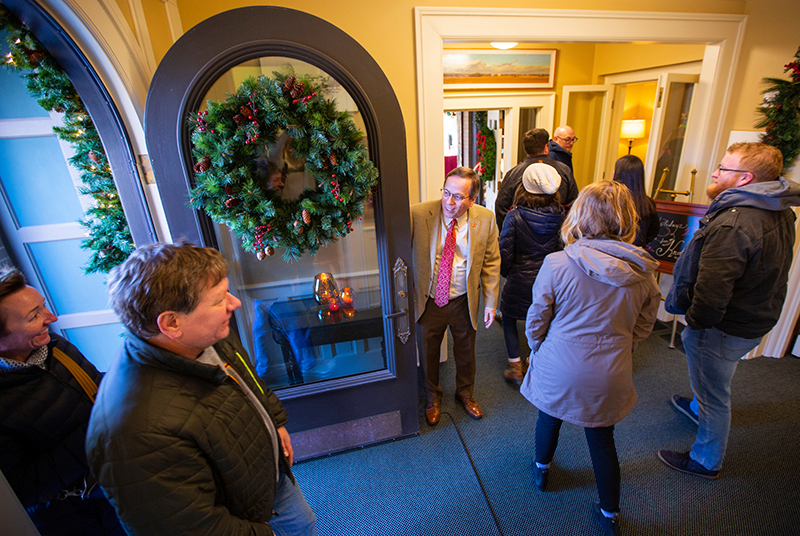
First spouse Robert Waggoner (center) welcomed guests to The Knoll during the 2019 WinterFest, the last time President Wendy Wintersteen hosted the event at their university home. File photo by Christopher Gannon.
WinterFest, a fun-filled run-up to both final exams preparation and the ensuing winter holidays, takes place Friday, Dec. 6, mostly in and around the Memorial Union.
The evening includes several holiday gift markets, campanile tours, horse-drawn wagon rides, Victorian open house at the Farm House Museum, and lots of indoor games and free food. The free WinterFest show on the Great Hall stage highlights the many talents of a troupe of Tanzanian performers, Zuzu African Acrobats. Their show starts at 7 p.m.; doors open at 6:30 p.m. Like all WinterFest activities, the performance is open to the public and appropriate for all age groups.
Two WinterFest traditions will be in new locations this year. The president's open house returns to The Knoll after three post-pandemic years in the spacious ground floor of Beardshear Hall. Due to the Cyclone football team's entry in the Big 12 Conference football championship Saturday morning in Dallas, President Wendy Wintersteen and her spouse, Robert Waggoner, will be enroute to Dallas Friday afternoon. Provost Jason Keith will host the Knoll open house. ISU entrepreneurs' Jingle and Mingle market moves indoors to the Beardshear ground floor space after launching outdoors last December.
Iowa State's WinterFest student organization hosts the event, in collaboration with the student engagement office, Student Union Board, AfterDark, First-Year Council, the Workspace, Maintenance Shop and CyBowl & Billiards. The event receives support from student government, Inter-Residence Hall Association, ISU Dining, Hy-Vee and Discover Ames.
Questions about the celebration may be directed to winterfest@iastate.edu or call 515-294-0410.
WinterFest schedule (free and at Memorial Union locations unless noted)
- Horticulture Club poinsettia sale, 9 a.m.-3 p.m., Union Drive Community Center, $12-$40 (cash or check preferred; cards accepted)
- Art Mart holiday sale, 11 a.m.-9 p.m., Art gallery, pottery, blown glass, jewelry, décor, accessories, paintings and more by artists from budding to professional. Sales support individual artists, The Workspace and the Gaffer's Guild. Dec. 6 is the final day of this four-day mart.
- President's open house, 3-5:30 p.m., The Knoll, join provost Jason Keith for live music by a student string quartet, seasonal treats and Knoll hot chocolate, enjoy eight holiday trees decorated by representatives of each college
- Forestry Club Christmas tree and wreath sale, 3-6 p.m., Reiman Gardens parking lot, $25-$110 (cash, check and card accepted)
- Jingle & Mingle holiday market, 3:30-7:30 p.m., Beardshear Hall ground floor, handcrafted gifts, food, art and more created by student and alumni entrepreneurs
- Decorating contest: Gingerbread houses, 4-5 p.m. (5-7 p.m. public voting), Room 3560, team registration has filled
- Holiday crafts, yeti painting, 4-8 p.m., The Workspace
- Chair massages, 4-9:30 p.m., Room 3580
- Stuff-a-Plush, 4-10 p.m. while supplies last, Campanile Room
- Bowling and billiards, 4-10:30 p.m., CyBowl & Billiards
- Cookie decorating and hot chocolate, 5 p.m. until supplies are gone, food court
- Andy Albright Jingle Jog (3K), 5-6 p.m., central campus, $20, proceeds support a scholarship in memory of former First Year Council member Andy Albright, register on the Student Organization Marketplace
- Campanile tours, 5-7 p.m., campanile, central campus
- Airbrush tattoos, 5-8 p.m., Cardinal Room
- Yuletide open house, 5-8 p.m., Farm House Museum, central campus, Victorian yuletide-themed activities, crafts and holiday treats
- Karaoke, 5:30-8:30 p.m., Room 2630
- Tree lighting, 6 p.m., across from Beardshear Hall, central campus
- Chili and cornbread, 6 p.m. until quantities are gone, Pine Room
- Horse-drawn carriage rides past Lake LaVerne, 6-9:30 p.m., departures from the west loop driveway
- Bingo, 6-10 p.m., Sun Room
- Performance: Zuzu African Acrobats, 7 p.m. (doors open at 6:30 p.m.), Durham Great Hall, Tanzanian troupe shares acrobatics, live music, singing and dancing based in 2,000 years of history
- Ice skating, 10:30 p.m.-12:30 a.m., Ames/ISU Ice Arena, 1507 Gateway Hills Park Dr., free admission and skate rental for the first 600 participants
